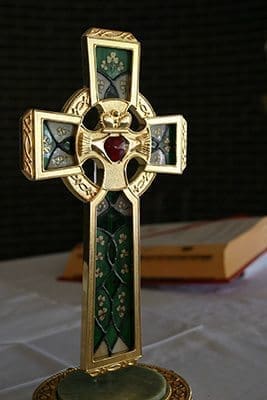The light of St. Patrick
By FATHER JOHN KIERAN, Commentary | Published March 18, 2016
A few miles from where I grew up there is a distinguished hilltop called the Hill of Slane. Legend holds St. Patrick lit a great Easter fire on the hilltop at Slane.
Back then the High King of Ireland reserved the right to personally kindle the first outdoor fire after the spring equinox. Patrick knowingly defied the High King and built a blazing fire that could be seen for miles. Seeing the unlawful fire, the king became furious and immediately sent troops to arrest the troublemakers.
Patrick was delighted to be arrested and taken to the king’s place at Tara, and there meet the great king. He had no fears; he trusted the Lord to protect him. He knew that the Holy Spirit would give him words to explain why he lit the fire and speak about the new Christian religion he preached.
The legend says Patrick easily convinced the pagan king about the Christian way and how it surpassed any nature religion. The story concludes saying the reluctant High King gave permission for the new religion to be preached all over Ireland. Sometime later the king and all his family were baptized.
Patrick’s Easter fire at Slane, along with the fire of the Holy Spirit burning in his heart, defeated paganism in Ireland. Subsequently the light of faith shining forth from Patrick changed the entire nation—and indeed the entire world.
Our readings for St. Patrick’s Day, March 17, are appropriate. They speak of Abraham’s call and his faith response. The man from Haran left home and country and became the great father in faith for the three monotheistic religions: Jews, Muslims and Christians. Likewise, Patrick left home and country to evangelize the Irish—and succeeded to become the spiritual patron of the Irish nation.
The adult Patrick is a model for evangelization. He accepted God’s call to return to Ireland and plant the Gospel in the very place where he had been held a captive slave for three years. The new Patrick returned about the year 432—no longer the victim of human trafficking, rather a priest evangelizer, captive only to the power and presence of Christ and determined to plant Christ’s church in Ireland. Years later, Patrick’s intense awareness of Christ’s presence in ordinary life was captured in the famous prayer:
Christ beside me, Christ before me, Christ behind me,
Christ within me, Christ beneath me, Christ above me,
Christ on my right, Christ on my left,
Christ in breadth, Christ in length, Christ in height,
Christ in the heart of everyone who thinks of me,
Christ in the mouth of everyone who speaks of me,
Christ in every eye that sees me,
Christ in every ear that hears me.
In his own writings, Patrick relates how he returned to Ireland as an immigrant for Christ with a threefold purpose:
- To evangelize and lead others to conversion in Christ;
- To teach the pillars of the Christian faith;
- To correct the evils in society, notably slavery and human trafficking.
Patrick is recognized as a world-class evangelizer. He left home and country to Christianize the Irish. He was smart and skillfully used his talents. He sought out the top of society, knowing that by evangelizing the leaders, they, in turn, would convert others. He had a heart for the marginalized and victimized. He was the first European to preach against slavery.
Long before the Dominican, Bartolome de las Casas, crusaded against slavery, and long before Benjamin Franklin said: “Slavery is an atrocious debasement of human nature” (“The First American” by H. W. Brands), Patrick, “the wounded healer,” condemned any form of servile indenture.
We Irish are grateful that the flames of faith planted by Patrick continue to enlighten the minds and hearts of his spiritual children all over the world. We are proud and grateful also for the many places named in his honor, places where the spirit and message of Patrick have been embedded and practiced. And pleased too for the many authors and musicians who keep the Patrician tradition alive by way of their writings and music.
The flame of Patrick is living still. We, in our time, should continually stoke these flames of Patrician faith and pass on the heritage just as we have received it.
First we must know the true Patrick:
- Know our saint as the victim of human trafficking and slavery;
- Know him who responded to God’s call to evangelize the Irish, and courageously return to the place of his captivity;
- Know his intense love for Christ and the urgency of salvation.
Patrick’s response to God is my “model” and should be a model for all evangelists. After his freedom from captivity, he could have enjoyed an easy life. He could have said I have done enough! Rather, he freely answered God’s call and returned to Ireland as a witness for Christ.
Recently I was on pilgrimage in Guatemala. There I met a young Irish lad, Larry, from New England. He is giving two to three years of service with the Maryknoll order, working with the poor in Guatemala City.
Larry reminds me of Patrick. This college grad is giving back to God and the Church in gratitude for his past blessings. He is continuing the Patrician tradition, generously, courageously, sacrificially giving of himself to testify for Christ in word and in deed.
All who wish to keep the tradition of Patrick must recognize his great achievement: namely, becoming a dedicated evangelist for Christ.
May his flame of pioneering faith live in each of us, so that all continue his great work for the glory of God.
Father John Kieran, a native of Ireland, is a senior priest of the Atlanta Archdiocese and chaplain of the Hibernian Benevolent Society of Atlanta.
